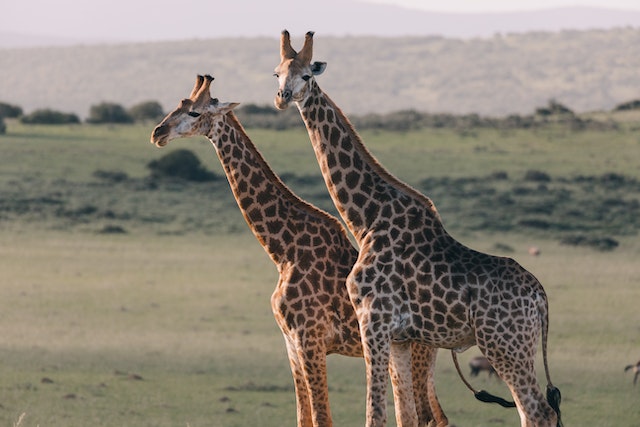
How can giraffes have such long necks? Giraffes have jointed vertebrae in their neck, a large amount of ligament, and an enormous heart to get the blood to their head.
Interestingly, giraffes used to be called camelopards, because they were kind of shaped like a camel and spotted like a leopard. That word came from the Ancient Greek “kamelopardalis”. The word giraffe came into English through French from the Arabic word “zarafah”, which came from the Persian words “zurna” meaning flute and “pa” meaning leg. I like the sound of fluteleg.
Giraffes are the tallest of all animal species. Adult male giraffes can grow up to 5.7 m tall and weigh 1,200 kg. They have very long legs, but their necks comprise 38% of their body length. They can’t reach the ground with their heads and they have to splay their front legs to get low enough when they want to drink from a river. Giraffes usually keep their neck at an angle of 50 to 60 degrees, but they can stretch it straight up when reaching for higher branches.
Nobody actually knows why giraffes have such long necks. There are two main theories, but there could be other possibilities. The first theory, the one that we probably all learned at school, is that giraffes have long necks so they can reach higher branches. There are a lot of herbivores in Africa that eat the grass and lower branches. By being taller, giraffes can eat the lower branches and compete with the other animals, but they can also reach the higher branches that the other animals cannot. This gives them more selection and more opportunity to eat. Being larger means they need more food, but being larger also means they have access to more food. This theory is disputed because during drought conditions giraffes with longer necks tend to die more than giraffes with shorter necks because they can’t get the nutrients they need.
The second theory is that they evolved their long necks to fight. Male giraffes bang their necks against each other when they are competing for female giraffes. This is the only way they fight, so a longer and stronger neck is more of an advantage and would be passed on through natural selection, However, if this were the reason for the necks, female giraffes wouldn’t need such long necks. There are other theories, but those are the main two.
So, we’ve looked at why giraffes have long necks, but how can they have such long necks. The first reason is their vertebrae. Despite the length of their necks, giraffes only have seven vertebrae. This is the same as most mammals. Giraffes have a few adaptations, Each one is about 25 cm, much longer than other mammals, and they are joined together with ball and socket joints. This type of joint gives them a huge range of motion in the necks and is why they can club each other with them. When giraffes are born, their necks are compressed because it would be too difficult to give birth to a fully extended giraffe.
Giraffes need a lot of ligaments to support that neck. The vertebrae that are over the giraffe’s shoulders have a vertical knob of bone on them. A thick ligament called the nuchal ligament connects here and runs all the way up the giraffe’s neck. The ligament counterbalances the neck and is stretchy so it holds the giraffe’s head up without the giraffe having to use much energy.
The giraffe’s heart is very large, an adult giraffe’s heart is 60 cm long, because it needs a lot of power to pump the blood up that high. However, a strong heart on its own isn’t enough. A huge heart pushing blood that high produces an enormously high blood pressure, The giraffe needs a special circulation to cope with this pressure. The arteries near their heart are very elastic, so they don’t burst and their jugular veins can constrict to slow down the blood as it descends back down the neck. They need another few adaptions as well. When they bend down to drink, they need a way to stop all of the blood sinking to their head and making their brain explode. They have a web of small blood vessels along their necks and the blood gets diverted into these when their heads are lowered, controlling the pressure. It can rapidly be released back into circulation when they raise their heads. Such a large heart and long neck means there is a lot of pressure in the blood when it is in the legs. Giraffes have thick, sturdy skin to stop the legs from rupturing, almost like compression socks. Their veins are also far below the surface of the skin so they don’t cut themselves and start bleeding. All of these adaptations allow them to have such long necks. And this is what I learned today.
Photo by Rachel Claire: https://www.pexels.com/photo/photo-of-two-giraffes-4577792/
Sources
https://creation.com/giraffe-neck-design
https://www.wired.co.uk/article/why-do-giraffes-have-long-necks
https://en.wikipedia.org/wiki/Giraffe
